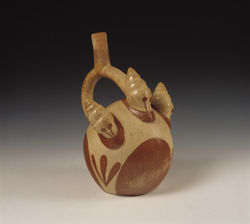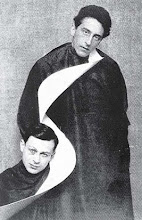Madain Salah in Al-Madina
During darker days just two weeks ago when I felt myself smarting, confused and anxious about a few things, Light suddenly shone, leading me to post an entry regarding Charles M. Doughty's 1888 masterpiece, Travels In Arabia Deserta.
Reading Doughty again, including of course, his extraordinary opening sentence:
"A NEW voice hailed me of an old friend when, first returned from the Peninsula, I paced again in that long street of Damascus which is called Straight; and suddenly taking me wondering by the hand "Tell me (said he), since thou art here again in the peace and assurance of Ullah, and whilst we walk, as in former years, toward the new blossoming orchards, full of the sweet spring as the garden of God, what moved thee, or how couldst thou take such journeys into the fanatic Arabia ?",
restored me to myself and made me feel that things might eventually be good again.
Arabie, French copper etching, 1700
While researching pictures to accompany the Doughty post, I came across what appeared to be fascinating, academically-oriented material relating to one of the structures Doughty encountered in his desert travels. Still standing, the Madain Salah in Al-Madina is located in modern Jordan in a part of the country formerly occupied by the ancient, somewhat mysterious kingdom of Nabataea (annexed by the Romans in 106 AD), whose most famous surviving relic is the city of Petra, a UNESCO World Heritage site.
The photo and text material I found was apparently assembled by a professor of religious anthropology named David Huntley-Palmer and concerned markings on the Madain Salah structure, which he identified as the Temple of Akuk, the ancient Nabataean Snail God. Professor Huntley-Palmer provided some compelling descriptions of this obscure sect on his website www.snailgod.com, which I found listed as a link on several websites featuring Nabataea-related information.
Common snail
I found this trove shortly before bedtime one night and the snail myths and images animated my dreams. For some reason, this autumn provided me many unrelated snail encounters in books, articles and pictures, and I learned a good deal about snails in the process. By mid-morning the next day, however, when I tried to do some additional research to supplement and verify what I had read in Dr. Huntley-Palmer's writings before including them in the Doughty post, I realized that the Snail God material was clearly a strange, dry hoax, a sort of internet research episode of the MTV series,
Punk'd.
Snail image, Moche pot, Lima, Peru, ca. 200 AD
I had attempted to do the most routine sort of cross-referencing of the Akuk research and the purported professor's identity and that of Reverend Matthew Walker, an orientalist mentioned in the materials, but could find absolutely nothing to support its accuracy or prove the professor's or Walker's existence. Some further research into Nabataea (a fascinating subject and a place I would like to visit if I ever decide to restore the Middle East to my future tourism itinerary) suggested that the Hoax Author had developed a kind of thoughtful, fictional fantasy riff about the curious kingdom, which had once been home to a population of 10,000 brave, independent, secretive souls (who actually seem to have worshipped the gods Dushara and al-Uzza), and that he showed the judgement and good taste not to call further attention to himself by laughing at his own joke. His work is a small, slightly Alfred Jarry-eque trifle (the snail motif looks a lot like Jarry's
gidouille) that can be enjoyed for itself, used to trigger other imaginative flights or both. The Snail God's tale therefore occupies an obscure place on the internet, like a mirage in the desert, a street sign a child has twisted in the wrong direction as a prank, a piece of Kilroy Was Here graffiti. Spending a few hours in the Snail God's company, although slightly creepy (see the illustration below for Maktnam, The Vengeful God), was far from the least enjoyable unplanned excursion I've made in my life.
Andy Goldsworthy, Leafsnail
Professor Huntley-Palmer's material, which in my mind deserves republication, follows below. Whoever he (or she) might be, the "research" shows that they're someone who has genuinely fallen under the spell of Doughty's
splendid work, about which T.E. Lawrence wrote:
"I have talked the book over with many travellers, and we are agreed that here you have all the desert, its hills and plains, the lava fields, the villages, the tents, the men and animals. They are told of the life, with words and phrases fitted to them so perfectly that one cannot dissociate them in memory. It is the true Arabia, the land with its smells and dirt, as well as its nobility and freedom. There is no sentiment, nothing merely picturesque, that most common failing of oriental travel-books. Doughty's completeness is devastating. There is nothing we would take away, little we could add. He took all Arabia for his province, and has left to his successors only the poor part of specialists. We may write books on parts of the desert or some of the history of it; but there can never be another picture of the whole, in our time, because here it is all said."
Austrohytida capillacea (Australian snail)
From www.snailgod.com:
The Temple of Akuk; Brotherhood of the Spiral; Akuk, the Nabatean Snail God; The Vengeful God
The Temple of Akuk
1.
The Temple of Akuk: The exact location of the temple of Akuk (the Nabatean Snail God) is not known but it is thought to be located in a hidden oasis in the desert of what is now Saudi Arabia. This is only known photograph. It was visited briefly in the late 19th century by Charles Doughty who included this photograph in the manuscript of the first edition of his
Travels in Arabia Deserta. The reference to the temple and to the oasis were removed from the final printed edition of 1888 due to representations to the publisher made by a an unknown third party. The manuscript itself is now missing but the photographs on this page were uncovered in the notes of the Reverend Matthew Walker, the late respected scholar of matters Arabian. There are occasional rumours that the oasis has been found by another explorer but there has been no definite proof. Doughty also left this photograph of the carvings on the pillar of the doorway. Note the depiction of both the left and right-hand spirals. Doughty also reports Nabataean characters inscribed on the walls of the temple giving us the name 'Akuk' but no photographs have survived. According to Doughty the hill in which the temple is located is covered in hand-drawn depictions of the snail god, presumably made by pious worshippers.
Supposed Doughty photograph of pillar carvings of snail imagery, Temple of Akuk
2.
Brotherhood of the Spiral: The traditional stories of the bedouin of Saudi Arabia speak sometimes of the Brotherhood of the Spiral who worshipped a giant snail. They are always described as a secretive sect and no-one knew whether their neighbour was a member or not. Some of the stories are clear fabrications with a strong 'Arabian Nights' feel about them. Others are very similar to stories about the Assassins and their stronghold on what is now the Syrian-Lebanese border. Nevertheless there would appear to be grains of truth hidden in the chaff. It is quite likely that the Brotherhood did, and possibly still does, exist. One rather dubious source is the Codex Arabica discovered in a Dresden museum in 1936. It is clearly late medieval in date, written in the degenerate church Latin of the time, but purports to be a copy of an earlier document also in Latin which was translated from an Arabic original. The codex is an allegorical tale about the struggle of good and evil and as such it must have attracted the early church fathers. The story of the codex is set in an unnamed desert and the two adversaries are the Followers of the Right-Hand Spiral and the Followers of the Left-Hand Spiral. The Followers were both concerned with the cult of a giant snail. The Left-Hand sect, while acknowledging the supremacy of the Great Snail, argued that there were other powers also worthy of worship. Their great heresy was that the shell was not necessary for divinity and that Ishtan, the Dark Slug should also be worshipped. Followers of the Left-Hand sect are described as being attracted to cruelty and dark deeds. If the codex is genuine then it is reasonable to assume that these Followers must be the same as the Brotherhood of the Spiral who appear in the bedouin stories and that the Great Snail is none other than Akuk. The temple itself, to judge from the clockwise and counter-clockwise spirals carved on the outside, was for all members of the Brotherhood. It is attractive to imagine a great schism between the Right-Hand and Left-Hand groups, perhaps to the detriment of the cult as a whole.

"Hand-drawn depictions of the snail god, presumably made by pious worshippers".
3.
Akuk, the Snail God: Akuk, the Snail God, is a little known god of the Nabataean people. The Nabataeans were a power in the Middle East in the first century BC and the first century AD. At one point they controlled most of what is now Jordan and the southern part of Syria. Their influence also extended into the deserts of Saudi Arabia. In the second century AD they were incorporated into the Roman Empire.The worship of Akuk seems to have been mostly confined to the desert regions. It is known that there is a temple located in a hidden oasis in the Arabian desert but the exact location of it is now lost. Information about the Snail God is sparse and mostly has to be deduced from the tales of 19th century explorers of the region and from the legends of the bedouin tribes who still live in the region.
Maktnam model supposedly based on Doughty sketches
4.
The Vengeful God: Akuk is said to have a dreadful aspect in which it pursues and punishes wrongdoers. Maktnam, the Vengeful God, is slow but very sure and will follow the evildoer across the world no matter how far he flees. The exact nature of Maktnam is unknown. This model (see illustration immediately above) is based on sketches and descriptions found in the effects of the explorer Charles Doughty who discovered the temple in the 19th century. It has been suggested that it is a representation of Maktnam but there is no evidence to support the idea.
NOTE to readers on snailgod.com website from its proprietor:
"My researches into this fascinating but obscure religion are very much in their early stages and these pages are little more than a collection of notes. If anyone has any information to share I would ask them please to contact me. My email address is dhp at snailgod.com.
David Huntley-Palmer
Emiritus Professor of Religious Anthropology"
"'Pataphysics is the science." --
Alfred Jarry, Gestes et opinions du docteur Faustroll pataphysicien : Roman néo-scientifique suivi de Spéculations (1911)


























